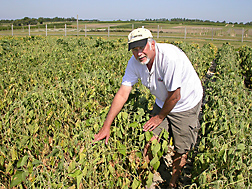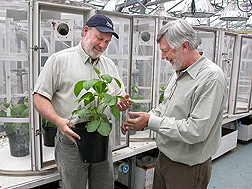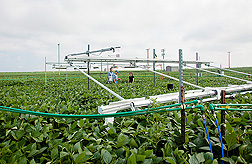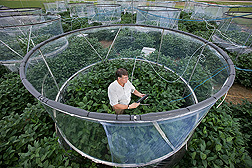Breeding Plants for a High-Ozone World
Geneticist Thomas Carter has bred soybeans for the Agricultural Research Service for 30 years, but for the last couple of years, he has been trying to solve a mystery: Why do the world’s most stress-resistant soybean types hail from a little village in far-northern Sweden?
Stress resistance is a rare commodity in soybean, but these Swedish varieties put up with a host of problems—drought, iron deficiency, toxic soil aluminum and salts, and even high levels of ozone.
Although Sweden is not known for its soybean production, Swedish breeders made a major breakthrough—but one that went unnoticed for decades by the soybean community and even by the breeders.
“We now know that they did something very right. The mystery is how,” Carter says.
Carter, who is in the ARS Soybean and Nitrogen Research Unit at Raleigh, North Carolina, has long been interested in breeding for stress resistance. Ozone resistance has become his most recent interest, in large part because of his collaboration with ozone expert Kent Burkey, a plant physiologist in the ARS Plant Science Research Unit at Raleigh.
Their stress studies led the scientists to the treasure trove of genetic resistance in Swedish soybeans, which appear to have an even more pronounced resistance to ozone than to the other stresses. Understanding the ozone effect may be a key to unraveling the secrets of the broad stress resistance of the Swedish soybeans.
Tracing the American Soybean’s Family Tree
Carter uncovered the resistance mystery after analyzing thousands of soybean types to generate the family tree of North American soybeans. From this, he found 30 ancestors, which together account for 92 percent of the genetic material in North American soybeans.
Carter screened these ancestors first for salt tolerance. He found two lines of vegetable soybeans—Fiskeby 840-7-3 and Fiskeby III, both from the Swedish village of Fiskeby—that were the most salt tolerant. Then he screened for aluminum tolerance, and again the Fiskeby plants stood out.
“Then, my colleagues and I saw the same thing with drought tolerance and ozone” and realized a pattern had emerged, Carter says.
ARS scientists in Raleigh and in Urbana, Illinois, study how increases in atmospheric greenhouse gases, particularly carbon dioxide and ozone, will affect crops, especially soybeans and wheat.
To screen the ancestors for ozone tolerance in a 2003 to 2005 study, Carter turned to Burkey for help. The two scientists combined the results of this study with breeder pedigree records and found that only a few U.S. cultivars trace their ancestry to the Fiskeby stress-tolerant types. “This indicates that there is great potential to increase tolerance to ozone and other stresses in North American soybeans by adding genes from Fiskeby,” Burkey says.
He and Carter and Jim Orf, a soybean breeder/geneticist at the University of Minnesota at St. Paul, have crossed Fiskeby III with ozone-susceptible Mandarin Ottawa and developed 240 breeding lines from the offspring. With the help of funding from the United Soybean Board, in Chesterfield, Missouri, the team is mapping the genes in these lines to see which genes are connected to resistance to ozone and the other stresses.
“This approach can be applied to other soybean-producing regions such as China, Brazil, and Europe,” says Burkey. “Their breeding programs, in turn, may offer us other important germplasm to explore for ozone tolerance genes.”
Cell Wall the First Line of Ozone Defense
Ozone enters leaf stomata as a gas and then dissolves in the liquid layer, called the “apoplast,” that surrounds plant cells. The apoplast is considered the first line of defense against pollutants, where ozone can be detoxified before it reaches the leaf cell surface and causes the damage that interferes with photosynthesis and reduces yields.
In the search for ways to improve crop ozone tolerance, Burkey and Cosima Wiese—associate professor of biology at Misericordia University in Dallas, Pennsylvania—recently began studying Fiskeby to see whether leaf apoplast antioxidants might be at least part of Fiskeby’s defense against ozone. Burkey and others have found that, in certain other species, vitamin C plays a role in keeping ozone from penetrating through the cell’s first line of defense. But soybean contains little vitamin C in the leaf apoplast, so they are looking for other antioxidants that may play a role.
Breeding Ozone-Tolerant Crops
ARS scientists in Urbana are taking a slightly different, but complementary, approach to the work of the Raleigh scientists. They are using SoyFACE (Soybean Free Air Concentration Enrichment) to screen soybean varieties for ozone tolerance and sensitivity. SoyFACE involves testing plants in open-air field conditions, under atmospheric conditions predicted for the year 2050. At that time, ozone concentrations are expected to be 25-50 percent higher than today’s concentrations.
The work is being done by molecular biologist Lisa Ainsworth, Amy Betzelberger, a graduate research assistant in the Department of Plant Biology at the University of Illinois at Urbana-Champaign, and geneticist Randall Nelson and other ARS colleagues at Urbana.
During 2007 and 2008, the team tested 10 soybean varieties that had been released between 1952 and 2003. These were selected from initial tests of 22 cultivars and experimental lines that had been evaluated for 4 years. The scientists found that, on average, exposure to 82 parts per billion (ppb) ozone reduced soybean yields by 23 percent in 2007, and exposure to 61 ppb reduced yields by 12 percent in 2008. They found significant differences in ozone tolerance among the 10 varieties. “But we didn’t see any significant improvement in ozone tolerance in soybean varieties released after the 1980s,” Ainsworth says. This again shows the potential and need for breeding more ozone-tolerant varieties.
Ozone Damage Seen From Above
In a 2002 to 2006 study led by the National Aeronautics and Space Administration, NASA scientists, Ainsworth, ARS plant physiologist Fitz Booker, and university scientists investigated widespread ozone damage to soybeans in Iowa, Illinois, and Indiana using ozone surface monitors, satellite instruments, and historical yield data. Ainsworth says that satellite information is useful for investigating ozone’s impacts on crop yields in areas without ground-monitoring networks, such as rural regions. “Satellite observations of farmland in other countries could provide important insight into the global extent of this problem,” she adds.
In the study, the scientists found that ozone levels above 50 ppb could reduce yields by about 10 percent in the Midwest Corn Belt, costing more than $1 billion in lost crop production.
Their findings are consistent with those from their SoyFACE studies and studies in outdoor open-top chambers.
Ozone levels in most urban areas of the United States have declined with improvements in emission controls. But ozone levels are expected to rise in countries like India and China, as growing populations are able to afford more cars and build more power plants. Another concern is that ozone levels will rise in developing countries, where people can least withstand losses of staple crops such as rice and wheat.
“All this research promises to give breeders the tools they need to help farmers by providing them with more ozone-hardy crop varieties. This is great science with a solid application, the goal of all ARS research,” Carter says.—By Don Comis, Agricultural Research Service Information Staff.
This research supports the USDA priority of responding to climate change and is part of Climate Change, Soils, and Emissions (#212) and Plant Genetic Resources, Genomics, and Genetic Improvement (#301), two ARS national programs described at www.nps.ars.usda.gov.
To reach scientists mentioned in this story, contact Don Comis, USDA-ARS Information Staff, 5601 Sunnyside Ave., Beltsville, MD 20705-5129; (301) 504-1625.
Ozone is a greenhouse gas found in smog. It is formed mostly when sunlight “cooks” automotive and industrial pollutants that originate from combustion of carbon-based fuels.
Ozone is the most damaging air pollutant to plants.
Fitz Booker, an Agricultural Research Service plant physiologist at the Plant Science Research Unit at Raleigh, North Carolina, says, “Ozone has long been known to affect a wide range of plants, including grasses, field crops, horticultural crops, and forests. Our research and that of other scientists has shown that many crops and forages are damaged by high ozone levels, including soybeans, wheat, cotton, oats, potatoes, rice, peanuts, tomatoes, grapes, alfalfa, clover, and barley.”
In fact, during the 1950s, Howard Heggestad (deceased) discovered that what were thought to be symptoms of a plant disease on tobacco leaves in the smoggy Connecticut River Valley was actually damage from ozone. In the Washington, D.C., area, he found similar damage to plants from ozone in smog. At the time, Heggestad was an ARS plant pathologist.
Globally, yield losses from ozone have been estimated at $14 to $26 billion for rice, soybean, corn, and wheat combined.—By Don Comis, Agricultural Research Service Information Staff.
Ozone Erodes CO2 Benefits for Plants
Experiments by Agricultural Research Service scientists at Raleigh, North Carolina, and Urbana, Illinois—and their university colleagues—have shown that future higher levels of ozone may cancel out some of the benefits to crops expected from higher carbon dioxide (CO2) levels.
For one thing, crops wouldn’t achieve the 30-percent increase in photosynthesis—and resulting higher yields—expected as CO2 levels continue to rise.
The scientists have also found that ozone can thwart expected high CO2 benefits by lowering crop quality. It can also help invasive weeds outcompete forage and other crops.
“We are beginning to look at interactions between ozone and diseases such as stripe rust and stem rust of wheat,” says David Marshall, research leader of the Plant Science Research Unit at Raleigh, and an expert on wheat rusts.—By Don Comis, Agricultural Research Service Information Staff.
"Breeding Plants for a High-Ozone World" was published in the July 2011 issue of Agricultural Research magazine.











